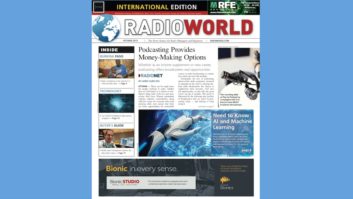Radio’s friend or foe?
Jun 1, 2003 12:00 PM, By Kevin McNamara
I tend to view most technologies as either emerging or breakthrough. Emerging technologies form the basis for, and typically address, a new approach to a problem. In some cases, an emerging technology could also represent a replacement solution to an existing situation. While the complex technical aspects of IBOC qualify it as a true technology, it is hardly a breakthrough.
Breakthrough technologies change the way we do things, possibly even causing a complete paradigm shift in our lives. One example of a breakthrough technology might be something as simple as the creation of wireless Ethernet hardware. Supported by the 802.11 standard, wireless Ethernet permits the connection of PCs to a network without wires � this changes the way that people work. Users are no longer tethered to a location where a connection is present.
The changes that IBOC brings to radio affect stations owners, managers and listeners.

Breakthrough technologies also need to address a social problem or need�I’m not sure IBOC addresses this either. Why? Let’s consider exactly what we are accomplishing.
IBOC is considered a viable method to move radio into a fully digital terrestrial service. It seems to do this well, through its ability to operate within a station’s assigned allocation, gradually moving from a hybrid mode to a fully digital mode.
Double play
The IBOC digital encoder provides two possible digital streams. The core stream and the enhanced stream, which provide higher bit rates respectively. The IBOC system assigns the respective streams to different parts of the spectrum.
IBOC systems have the ability to scale back to a lower bit rate in locations with poor signal. In the case of hybrid implementations, the digital streams will blend into the analog. In practice, if the station has enabled the enhanced stream, the receiver should switch from enhanced to core and ultimately to analog, as a listener moves away from the transmitter site. How will this blending ultimately affect the listener? Will phase delays and other artifacts produced by this blending end up causing listener fatigue?
Perhaps the largest issue surrounding IBOC presently is the NRSC’s recent announcement that it is temporarily suspending its IBOC standards-setting process due to concerns over the quality of the 36kb/s PAC coding technology. Actually, the statement left little room for interpretation: “DAB subcommittee members…do not consider the audio quality demonstrated by the Ibiquity 36kb/s PAC technology to be suitable for broadcast.” The original demonstrations of this technology by Ibiquity used the MPEG-2 AAC encoder, which by all accounts sounded measurably better than the present analog technology used over the past several decades. Will this ultimately be resolved? Possibly, but it may slow the initial deployment of IBOC.
Another issue is the reality that most broadcast transmission systems are less than perfect. In my experience, few station owners have been willing spend the extra time and money necessary to optimize the transmission system. Generally, transmission system problems are dealt with as a result of a failure, and even then the expectation is to address the specific problem only.
In general, the performance of the current generation of FM antennas ranges from good to excellent, however, that performance can be degraded by a number of factors, including reflections and coupling from the mounting structure, mismatches, element damage, ice build-up and damage to the transmission line.
Despite the recent NRSC announcement, receiver manufacturers still plan to release production units later this summer.

Another issue I have not heard discussed is the effect of poor axial ratio (unequal amplitudes and phase between horizontal and vertical polarization). IBOC uses the fully allocated spectrum�either along with the analog signal or in fully digital mode. These problems may go unnoticed using the traditional analog system, however, it is not clear whether they have an effect on the ODFM subcarriers that are located away from the center carrier frequency, particularly in an urban environment where multipath is common. Let’s not forget the bandwidth limiting effects of poorly tuned final cavities.
Another concern I haven’t seen addressed are the results of RF intermodulation products that can be a problem at locations that host multiple stations using separate antennas. Tests were performed on a station operating through a master antenna system with reasonable results, however, there are a variety of master antenna systems presently in operation that may not perform as well due to the type of design, filtering scheme, station frequency separation or antenna system bandwidth limitations.
Finally, whether IBOC can live satisfactorily with analog subcarriers will be yet another potential obstacle. Tests performed by Ibiquity and the NRSC indicate that the IBOC subcarriers should be able to operate with minimal interference to subcarriers, but acknowledge the potential for problems. The FCC has also recognized this problem and stated with its rulemaking that in the event IBOC interferes with subcarriers, the licensee of the station needs to work toward a remediation. One of the main concerns of the FCC is the potential interference to SCA broadcast reading services that target blind listeners.
I would suspect that the implementation of AM IBOC would present a major challenge to engineers for many of the same reasons I stated earlier regarding the FM system. The ultimate effects of improperly tuned phasing systems and network components will become apparent quickly. At least IBOC is not being permitted to be used in nighttime operation yet and you can scrap that AM stereo exciter. Also, what will happen when the AM listener is traveling near power lines or a multitude of other noise sources? Does the IBOC receiver blend to static?
So is IBOC a friend or foe? I think a fully digital terrestrial service is certainly in our future, but the path will be rocky at best. Radio has always had the advantage of being local and of serving that local area better than a network. The ability to broadcast a fully digital signal may seem to put radio at parity with satellite-delivered services and CDs, however, without exploiting that unique local position from a programming perspective, I doubt IBOC or any other approach will keep radio viable.
McNamara is president of Applied Wireless, New Market, MD.












